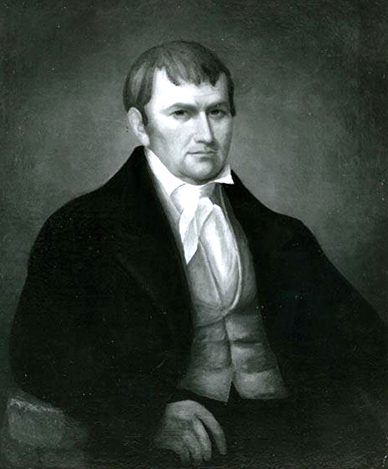James Robertson (James Robertson)

James Robertson was born in Brunswick County, Virginia, of Scots-Irish and English descent. Around 1750, his father relocated to Wake County, North Carolina. He worked on his father’s farm and had limited formal education. In 1759, young Robertson accompanied explorer Daniel Boone on his third expedition to lands beyond the Allegheny Mountains. The party discovered the “Old Fields” (lands previously cultivated by generations of Native Americans) along the Watauga River valley at present day Elizabethton, Tennessee, which Robertson planted with corn while Boone continued on to Kentucky. Robertson returned to North Carolina and married Charlotte Reeves in 1767. He became involved with the Regulator movement. They banded together a group of settlers to return to the Watauga River, which they believed to be in Virginia. In 1772, Robertson and the pioneers who had settled in Northeast Tennessee (along the Watauga River, the Doe River, the Holston River and the Nolichucky River) met at Sycamore Shoals to establish an independent regional government known as the Watauga Association.
However, in 1772, surveyors placed the land officially within the domain of the Cherokee tribe, who required negotiation of a lease with the settlers. Tragedy struck as the lease was being celebrated, when a Cherokee warrior was murdered by a white man. Robertson’s skillful diplomacy made peace with the irate Native Americans, who threatened to expel the settlers by force if necessary. In 1775, a treaty was held between the Cherokee and a delegation of the Transylvania Company, headed by Richard Henderson. Under the Treaty of Sycamore Shoals (or the Treaty of Watauga), the Transylvania Company purchased a vast amount of land from the Cherokees, including most of present-day Kentucky and part of Tennessee. The treaty was technically illegal since the purchase of land from Native Americans was reserved by the government (the British, the governments of Virginia and North Carolina and, later, the United States, all forbade private purchase of land from Indians). During the treaty, Dragging Canoe, son of the Cherokee chief Attacullaculla, made a speech condemning the sale of Cherokee land and broke from the general Cherokee tribal government to form the sub-tribe known as the Chickamauga Cherokee. After Henderson’s Transylvania Company had bought Kentucky (although other tribes claimed it, such as the Shawnee), Daniel Boone was hired to widen the Indian path over Cumberland Gap to facilitate migration. This road became known as the Wilderness Road.
James Robertson’s group remained at Watauga in peace until July 1776, when Chief Old Abraham of Chilhowee led a Cherokee contingent that attacked Fort Watauga (a log fort built for defense purposes by the Watauga Association). A 40-man contingent commanded by John Carter with Robertson and John Sevier as lieutenants withstood a siege of about two weeks. After the Cherokees were subjugated later that year, the governor of North Carolina appointed Robertson Indian agent to reside at the Cherokee capital to hold them in check and thwart the designs of the British during the American Revolution. In the spring of 1779, he and John Donelson founded Fort Nashborough, later to become Nashville, then part of the Washington District, North Carolina. He represented Davidson County (home of Fort Nashborough in present-day Tennessee, not to be confused with the modern Davidson County, North Carolina), in the North Carolina legislature and had the settlement established as a town, and also established the first school there, Davidson Academy. James Robertson was offered peace and the free navigation of the Mississippi River by the Spanish governor, in exchange for his leaving the United States and establishing — along with the Watauga settlement and Kentucky — an independent government. He refused to consider the matter. In 1790, he was appointed brigadier-general of the territorial militia by U.S. President George Washington, and his military services did not end until 1796. He shared with Sevier the honor and affection of Tennesseans, and he held the post of Indian commissioner until his death in 1814. James Robertson died near Memphis and was buried there but re-interred in 1825 in the Nashville City Cemetery. His son, Felix Robertson (1781-1865), served as Mayor of Nashville from 1818 to 1819. In World War II the United States liberty ship SS James Robertson was named in his honor.
Born
- June, 28, 1742
- USA
- Brunswick County, Virginia
Died
- September, 01, 1814
- USA
- Chickasaw Bluff, Tennessee
Cemetery
- Nashville City Cemetery
- Nashville, Tennessee
- USA



